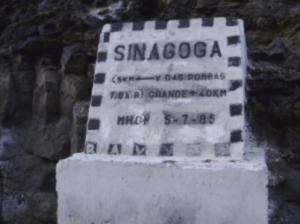 Jews first reached Cape Verde in the 1400s, when Portugal colonized the then uninhabited islands. During the early colonial era, Portuguese Cape Verde had a population of so-called lançados (meaning “thrown-out ones”) consisting of exiled Crypto-Jews and New Christians.
Jews first reached Cape Verde in the 1400s, when Portugal colonized the then uninhabited islands. During the early colonial era, Portuguese Cape Verde had a population of so-called lançados (meaning “thrown-out ones”) consisting of exiled Crypto-Jews and New Christians.
Many Jews came to the island directly from Portugal after their deportation in 1460, while others trickled in throughout the 19th century.
 The second influx of Jews arrived in the 19th and 20th centuries from Morocco and Gibraltar in search of economic opportunity. Based on the names in the cemeteries, the majority came from the Moroccan cities of Tangier, Tetouan, Rabat, and Mogador (now Essaouira). Since many of the Jewish immigrants were bachelors, they married and assimilated into the island’s local population.
The second influx of Jews arrived in the 19th and 20th centuries from Morocco and Gibraltar in search of economic opportunity. Based on the names in the cemeteries, the majority came from the Moroccan cities of Tangier, Tetouan, Rabat, and Mogador (now Essaouira). Since many of the Jewish immigrants were bachelors, they married and assimilated into the island’s local population.
Today remnants of the Jewish settlement remain including a village named Sinagoga and 4 Jewish cemeteries. Jewish names such as: Auday, Anahory, Benchimol, Benoliel, Cohen, Levy and Wahnon persist in the current population.
 Many descendants of the Jewish immigrants are aware of their heritage, and proud of it too, even though they have identified as Christians for generations. By the late 20th century most of the Jewish community had either left Cape Verde for the State of Israel or intermarried with the Catholic population.
Many descendants of the Jewish immigrants are aware of their heritage, and proud of it too, even though they have identified as Christians for generations. By the late 20th century most of the Jewish community had either left Cape Verde for the State of Israel or intermarried with the Catholic population.
However, there are still four Jewish cemeteries in existence on the islands of Cabo Verde. There is currently a heritage society, which is dedicated to restore these cemeteries.